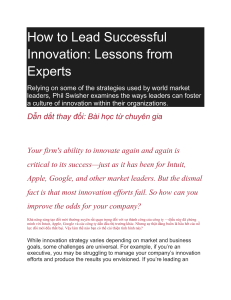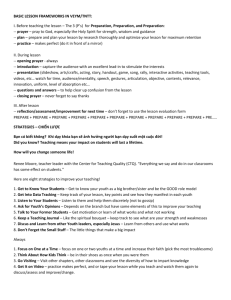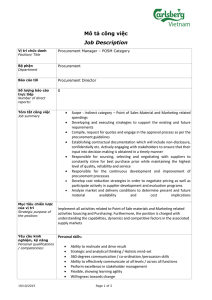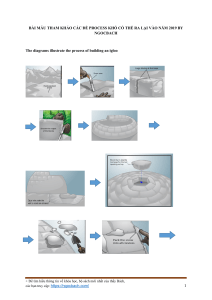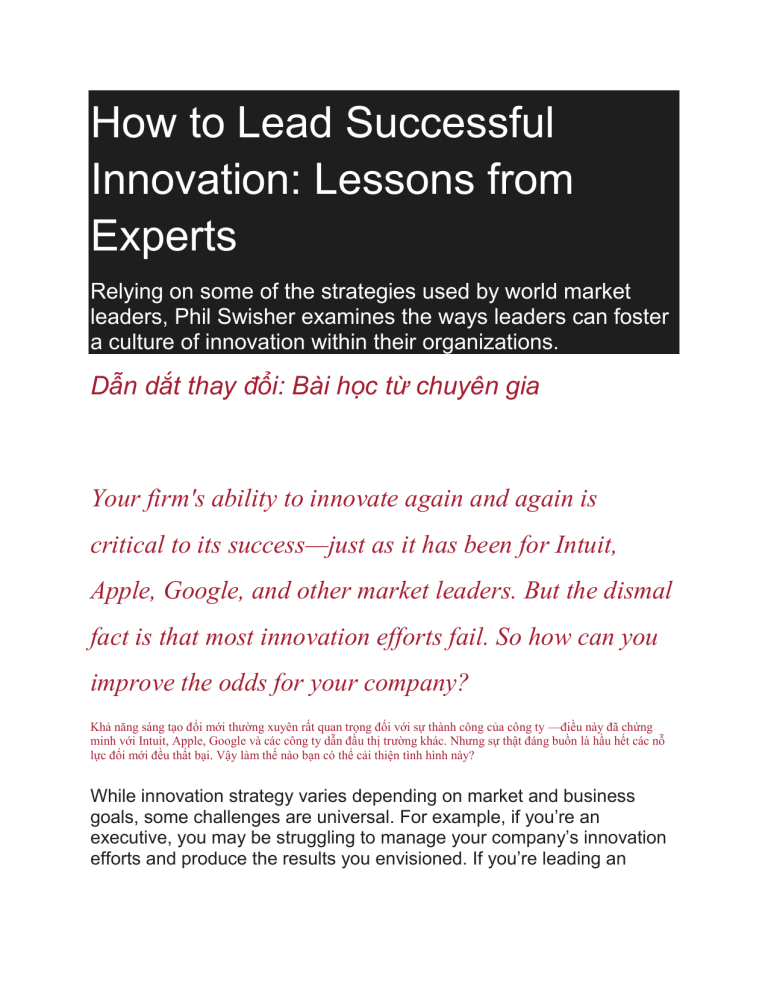
How to Lead Successful Innovation: Lessons from Experts Relying on some of the strategies used by world market leaders, Phil Swisher examines the ways leaders can foster a culture of innovation within their organizations. Dẫn dắt thay đổi: Bài học từ chuyên gia Your firm's ability to innovate again and again is critical to its success—just as it has been for Intuit, Apple, Google, and other market leaders. But the dismal fact is that most innovation efforts fail. So how can you improve the odds for your company? Khả năng sáng tạo đổi mới thường xuyên rất quan trọng đối với sự thành công của công ty —điều này đã chứng minh với Intuit, Apple, Google và các công ty dẫn đầu thị trường khác. Nhưng sự thật đáng buồn là hầu hết các nỗ lực đổi mới đều thất bại. Vậy làm thế nào bạn có thể cải thiện tình hình này? While innovation strategy varies depending on market and business goals, some challenges are universal. For example, if you’re an executive, you may be struggling to manage your company’s innovation efforts and produce the results you envisioned. If you’re leading an innovation project, perhaps you’re finding it hard to garner the support you need from senior management. Mặc dù chiến lược đổi mới khác nhau tùy thuộc vào thị trường và mục tiêu kinh doanh, nhưng một số thách thức là phổ biến. Ví dụ: nếu bạn là giám đốc điều hành, bạn có thể gặp khó khăn trong việc quản lý các nỗ lực đổi mới của công ty và tạo ra kết quả như bạn đã hình dung. Nếu bạn đang dẫn dắt một dự án đổi mới, có lẽ bạn sẽ khó thu hút được sự hỗ trợ từ quản lý cấp cao. In either case, you’re not alone. Many successful and well-intentioned business leaders find themselves stymied in the quest for innovation. Trong các trường hợp, bạn đều không đơn độc. Rất nhiều nhà lãnh đạo thành công và có thiện chí tốt đều cảm thấy bị cản trở trong việc đổi mới To demonstrate, here I explore three quotes from well-known innovation experts that get to the heart of why innovation is so difficult. This analysis can help you shape an approach for leading successful innovation at your organization. Ở đây tôi đưa ra 3 trích dẫn từ những chuyên gia đổi mới nổi tiếng đi sâu vào việc tại sao đổi mới lại khó đến vậy. Phân tích này sẽ giúp bạn định hình lại cách tiếp cận đổi mới để thành công hơn ở tổ chức của mình The Innovation Leader as Champion and Advocate Clayton Christensen, a Harvard Business School professor and author of The Innovator’s Solution, says that for an innovation program to get off the ground and mature, a senior leader must personally champion the cause. "The senior executives of a company that seeks repeatedly to create new waves of disruptive growth have three jobs: The first is a near-term assignment: personally to stand astride the interface between disruptive growth businesses and the mainstream businesses to determine through judgment which of the corporation’s resources and processes should be imposed on the new business, and which should not. The second is a longer-term responsibility: to shepherd the creation of a process that we call a ‘disruptive growth engine,’ which capably and repeatedly launches successful growth businesses. The third responsibility is perpetual: to sense when the circumstances are changing, and to keep teaching others to recognize these signals. Until processes that can competently manage disruptive innovation have coalesced, the personal oversight of a senior executive is one of the most crucial resources that disruptive businesses need to reach success." 1: MEDIATING THE CONFLICT BETWEEN INNOVATION AND CORE BUSINESS Unless a leader is starting a business from scratch, he or she must manage the innovation program while keeping the core business functions moving forward. Mediating the natural tension between the two can be quite a challenge, but it’s a conflict you must address. Truth be told, core businesses can steamroll innovation efforts if you let them. Innovation programs disrupt the norm, encroaching on what core business colleagues may perceive as their own turf. Some managers will no doubt feel threatened, and their anxiety will express itself through concerns about risk. Eventually, someone at the executives’ table will say, “These innovation folks are doing things that are costly and risky, and we need to shut that project down.” If you’re the one responsible for making that decision, you need to know how and when to push back and protect the company’s ability to innovate. 2: FUELING THE DISRUPTIVE GROWTH ENGINE No matter the kind of business, senior executives have to create a system that continuously nurtures innovation. The form your disruptive growth engine takes will depend on your unique goals. Maybe you’re shepherding product R&D and exploring technologies that could impact the future of the business. Or perhaps you’re managing a corporate venture capital that is trying to compete with more nimble venture capital firms. In any case, you need to continually fuel the engine. It helps to think of the disruptive growth engine as an entire ecosystem. It includes strategic goals, budget allocations, incentives, executive support, a solid talent pool, and suitable leadership and management processes. If your innovation team has the support of the CEO, a healthy budget, creative freedom, and proper incentives, then the likelihood of high team engagement and successful outcomes will be far greater. If your growth engine is faulty, talent will leave, and your innovation efforts will stall. 3: EXPLORING OPPORTUNITIES AND THREATS To add value to the innovation process, you need to stay ahead of the curve. Keep an eye on trends in the marketplace. If, for example, your competitor set is shifting, your established business could become vulnerable to start-ups. To anticipate threats, you must also think more broadly. New developments across a wide spectrum can affect your business over time. If you nurture your own intellectual curiosity and keep tabs on what’s happening outside your market, then you’re far more likely to keep an open mind when a colleague comes to you with something that at first seems irrelevant. You’ll be ready for that next wave of innovation. The Leader as Explorer Brad Smith, CEO of Intuit, emphasizes the importance of the inquisitive leader: "The best leaders don’t need to have all of the answers. They ask the right questions. There are three questions I always ask when meeting with teams: 1. What surprised you to the upside, and what did you learn that drove the upside versus expectations? 2. What surprised you to a downside, and what did you learn that caused the downside surprise? 3. What barriers are getting in the way of what you are trying to achieve? The first two have to do with savoring the surprises that can often lead to breakthroughs. The third helps me understand where I can help the team be more successful." It can be hard for established companies to innovate because it is an unnatural process. That’s why start-up firms create many of today’s innovations. But it doesn’t have to be that way. To be successful at leading the innovation function within a larger organization, executives need to understand that innovation requires a kind of day-to-day management that is very different from business as usual. As a leader, it’s natural to fall back on behaviors that have always worked well for you. But if you apply typical line management techniques—managing toward deliverables, metrics, and dashboards, ROI, and so on—to innovation efforts, you’ll fail dramatically. So, what do you do instead? A successful innovation process is based on iterative experimentation that—as Brad Smith explains above—is nurtured by an involved executive who asks the right questions. You pose a hypothesis, test it, evaluate the outcome, and decide what to do next. In addition to providing resources, you must collaborate with the team, help expose the most important learning, and bring your unique knowledge and perspective to the table. Successful executives know how to facilitate that process, how to contribute to it—and when to get out of the way. The Leader as Agile RiskTaker Finally, Eric Ries, author of The Lean Startup, emphasizes the value of a continual feedback. "The fundamental activity of a startup is to turn ideas into products, measure how customers respond, and then learn whether to pivot or persevere. All successful startup processes should be geared to accelerate that feedback loop." The most important goal of innovation is to gain competitive advantage by increasing the speed and effectiveness with which your company learns—and acts on that learning. Innovation is about experimentation— failing early and often. That iterative process operates at several different levels. Eric Ries talks specifically about market-based experimentation in his book The Lean Startup. According to Ries, the leader must foster the organization’s ability to learn quickly from the market and become better at recognizing when to persevere, and when to correct the course of action. As Ries acknowledges, failure is a key component of learning. The problem is, most of us don’t like to fail. It’s the leader’s job to keep the organization trying, failing, and learning—and acting on that learning—as quickly and effectively as possible. In other words, it’s the leader’s job to counter that tendency to avoid failure. Many small failures can lead to a big success. Putting the Lessons to Work For You-And Your Organization Innovation is different—and it’s important to adjust your leadership approach for innovation initiatives. You can transform the lessons above into action. Share them with your team—or your boss—and talk about the important differences between managing traditional operations and leading innovation. These conversations can jumpstart collaborations that will drive real improvements in your company’s ability to innovate—and succeed. SHARE THIS
